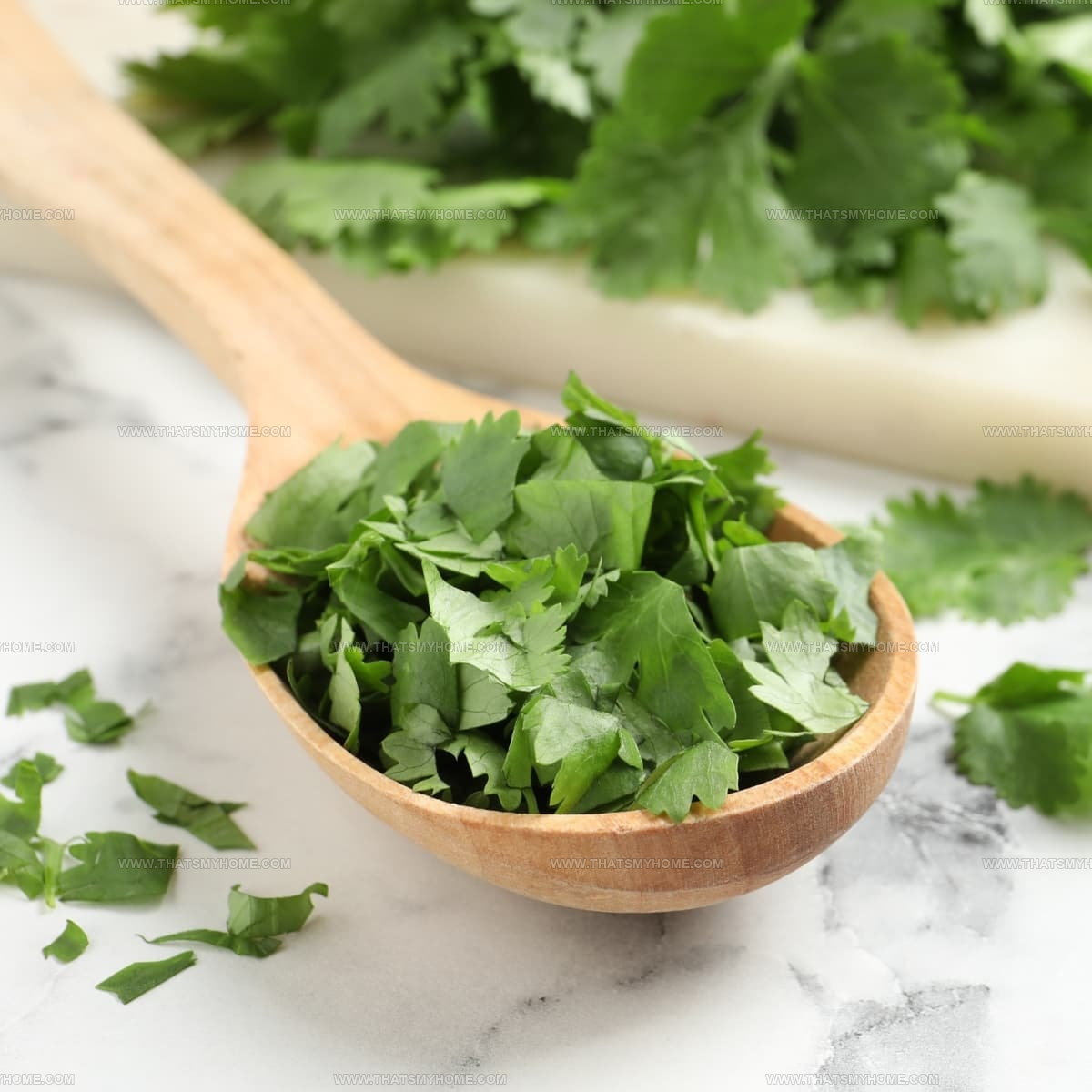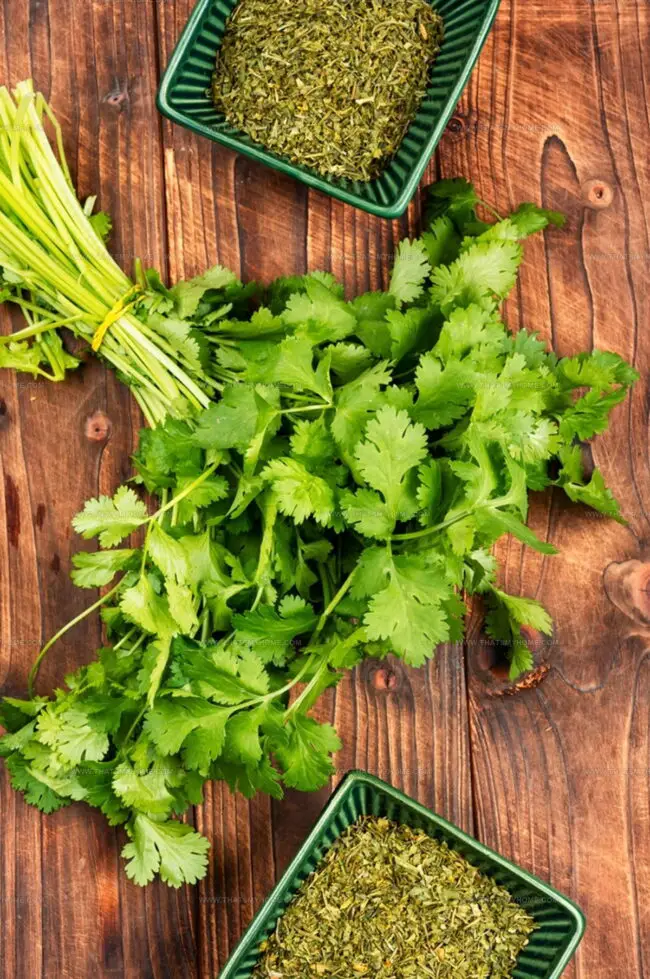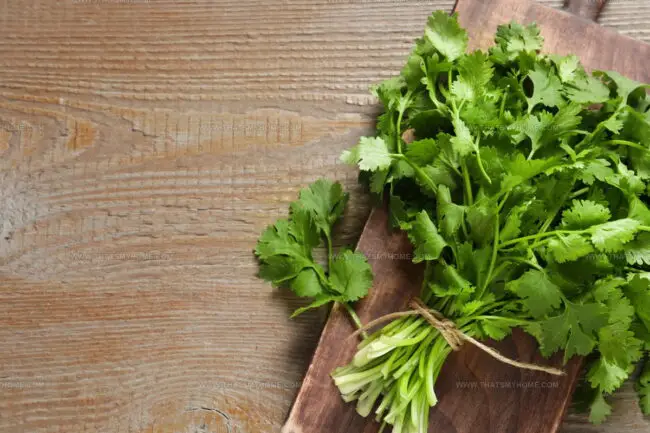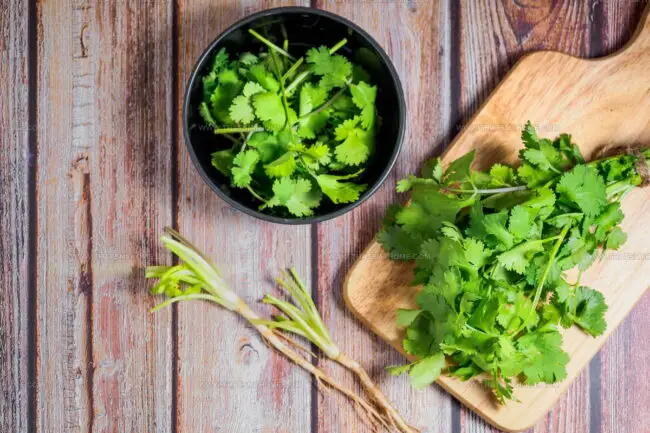13 Fresh Cilantro Alternatives: Flavor Twins for Your Dishes
Cilantro is known for its bright, citrusy flavor that livens up salsas, salads, and many ethnic dishes.
If cilantro isn’t accessible or preferred, alternatives like parsley, culantro, or mint can provide fresh herbal notes with less pungency.
Fresh versus dried options offer different intensities, so choosing the right form matters.
These thirteen best cilantro substitutes offer flexibility for a range of flavor preferences and cuisines.
Understanding the role cilantro plays helps you select an effective replacement without overpowering your dish.
With these alternatives, you can keep your recipes fresh and balanced.
Explore diverse options to tailor your cooking even when cilantro is off the table.
Replacements of Fresh Cilantro
Fresh cilantro brings a bright, herbal note. Without it, you can still achieve a fresh, green flavor. The goal is to keep that lively taste in your dish.
Parsley
Parsley is a reliable substitute for cilantro because of its fresh, slightly peppery taste that closely resembles cilantro's brightness without the divisive soapy flavor some people experience.
Many chefs recommend this swap at a simple 1:1 ratio when working with recipes that call for fresh herbs as garnishes or flavor enhancers.
The main difference lies in parsley's milder, grassier profile compared to cilantro's more distinctive citrusy undertones that can be essential in certain ethnic cuisines.
For dishes where those citrus notes aren't crucial, such as general salads or light pasta dishes, the substitution works seamlessly and keeps meals looking appetizingly green.
Most home cooks already have parsley on hand, making it a convenient alternative when cilantro isn't available or when serving guests who might dislike cilantro's polarizing taste.
Mint
Substitution between mint and cilantro requires careful consideration as these herbs offer distinctly different flavor experiences despite their shared freshness.
Mint delivers a sweet, cooling sensation that lingers pleasantly on your palate, making it perfect for desserts and certain beverages.
Cilantro, by contrast, brings an earthy, slightly bitter and tangy profile that some people love while others find soapy due to genetic differences in taste perception.
For recipes calling for mint, parsley works as a milder 1:1 replacement that you can adjust to match your desired intensity.
Many culinary traditions worldwide treasure these herbs for their ability to elevate dishes with their unique characteristics, though they're rarely interchangeable due to their signature flavor profiles.
The best substitution choice ultimately depends on the specific dish and what flavor notes you want to highlight.
Thai Basil
Substituting Thai basil for cilantro offers an exciting twist with its slightly spicy taste and hints of anise and licorice that can truly elevate your meals.
This versatile herb stands up remarkably well to high-heat cooking, unlike cilantro which often wilts away.
Many Thai and Southeast Asian cuisines feature this robust herb in popular dishes such as pho, curries, and fresh salads where its distinctive flavor shines through.
For best results when making the switch, simply use equal amounts of Thai basil in place of cilantro in your recipes (a straightforward 1:1 ratio).
The unique flavor profile and impressive heat resistance of Thai basil make it an excellent alternative that might even become your new favorite kitchen staple.
Papalo
Papalo offers a wonderful alternative to cilantro with its unique flavor profile that blends arugula and mint notes, making it highly sought after in South American cuisine.
The leaves of this versatile herb pack an impressive nutritional punch, delivering essential antioxidants, vitamins, and minerals that benefit your body.
Many chefs recommend papalo as a perfect garnish for tacos, soups, and traditional dishes where cilantro typically shines, though you should only use the leaves and avoid the stems for the best taste experience.
When cooking with papalo, a good rule of thumb is to use just 1/3 of the amount you would normally use for cilantro since its flavor can be more intense.
This remarkable herb grows abundantly throughout South America, where local cooks have treasured it for generations as both a flavor enhancer and health booster.
Fresh Dill
Dill is a fantastic cilantro substitute with its distinctive flavor and impressive health benefits.
Rich in antioxidants, this herb helps reduce inflammation and improve digestion while providing good amounts of vitamins A and C.
The taste difference means dill won't work perfectly in every cilantro-based recipe, but using half the amount of fresh chopped dill can still create delicious results in many dishes.
You around the world appreciate dill's versatility when their cilantro supply runs out or when they want to experiment with new flavor profiles.
Skilled chefs often intentionally swap these herbs to create unexpected flavor combinations that surprise and delight dinner guests.
Rau Rum
Vietnamese coriander, also called rau ram or laksa leaf, stands out as the perfect substitute for cilantro in many recipes due to its similar citrusy and peppery flavor profile.
This leafy herb blends seamlessly into dishes that traditionally call for cilantro, adding comparable fresh and aromatic qualities that enhance the overall taste experience.
The substitution works best at a simple 1:1 ratio, making it easy for home cooks to make the switch without complicated measurements.
While rau ram does carry its own unique character, the slight flavor difference can actually bring an interesting new dimension to familiar recipes.
For those with cilantro allergies or anyone who experiences the notorious "soap taste" associated with cilantro, this alternative offers a delicious solution that doesn't compromise on flavor or freshness.
Celery Leaves
Celery leaves make a solid backup for cilantro in recipes despite their milder, less pungent profile.
These green substitutes add a fresh, slightly herbaceous quality to dishes though they lack cilantro's distinctive citrusy and peppery character.
Many cooks increase the amount when swapping in celery leaves to compensate for their subtler flavor profile.
The final taste won't perfectly match the original recipe, but celery leaves still contribute a pleasant freshness that works well in many dishes.
For best results, simply replace cilantro with an equal amount of celery leaves in a straightforward 1:1 ratio.
What to Replace Dried Cilantro
Dried cilantro is milder than fresh but still aromatic. When it’s not available, you can find another way to add that herb-like touch. Balance is the key.
Cumin
Cumin is a possible stand-in for cilantro, despite their distinct flavor differences - cilantro offers fresh, citrusy notes while cumin brings warm, earthy tones with subtle hints of nuttiness.
Many cooks appreciate that cumin can complement dishes where cilantro might normally shine, adding complexity rather than trying to perfectly mimic the original herb.
The key to successful substitution lies in understanding that cumin creates a new flavor dimension entirely, which can work wonderfully alongside other ingredients in your recipe.
For best results, a general guideline suggests adding an extra quarter teaspoon of cumin for each teaspoon of dried cilantro called for in recipes.
Some cuisines naturally pair these two flavors together, making the transition less jarring when one replaces the other in certain traditional dishes.
Coriander Seeds
Coriander seeds serve as a reliable substitute for fresh cilantro since they both originate from the same plant, coriandrum sativum, which produces both the leafy herb and dried seeds.
The similar flavor profile makes coriander seeds a sensible alternative when fresh cilantro isn't available, though their taste is notably milder and less intense than the bright, distinctive flavor of the fresh leaves.
For best results, toasting and grinding the seeds before adding them to dishes can enhance their aromatic qualities and release more of their essential oils.
You can easily substitute coriander seeds for dried cilantro at a simple 1:1 ratio in most recipes, making them perfect for curries, soups, and marinades when the fresh herb is out of season or unavailable.
These seeds also offer a longer shelf life than fresh cilantro, allowing you to keep them on hand for unexpected cooking needs.
Caraway Seeds
Caraway seeds provide a warm, earthy flavor with hints of citrus and anise that can work as a surprising replacement for cilantro in many recipes.
The subtle complexity of caraway makes dishes interesting without overpowering other ingredients, though its taste differs slightly from cilantro's refreshing, herbal character.
For best results, simply use caraway seeds and dried cilantro in equal amounts when making this swap.
The seeds particularly shine in hearty European dishes where their distinctive taste creates a pleasant alternative that most dinner guests won't even recognize as a substitution.
Dried Parsley
Dried parsley offers a subtle herbal flavor with mild grassy notes, making it an excellent substitute for dried cilantro in many recipes.
Most home cooks already have this common herb in their spice rack, which adds convenience when you need a quick replacement.
The mild taste won't overpower your dish while still providing that essential herbal element that cilantro would typically bring.
For best results, simply use one teaspoon of dried parsley to replace one tablespoon of fresh chopped cilantro in your cooking.
This substitution works particularly well in cooked dishes where the distinct flavors become more mellow and integrated with other ingredients.
Curry Powder
Curry powder is an excellent substitute for dried cilantro when your spice rack falls short.
This aromatic blend contains many similar flavor notes that can mimic cilantro's distinctive taste in most recipes.
Simply use half the amount called for in your dish since curry powder packs more intensity than dried cilantro alone.
The rich combination of spices like coriander, cumin, and turmeric provides wonderful depth to curries, soups, and marinades without completely changing the intended flavor profile.
You appreciate this handy substitution trick because curry powder remains fresh in pantries much longer than dried herbs and brings an interesting twist to familiar dishes.
Dried Dill
Dried dill is a fantastic alternative to dried cilantro with its comparable zest and flavor profile that can enhance many dishes.
The switch offers health benefits too, since dill contains more antioxidants and anti-inflammatory properties than its counterpart.
This herb substitution works especially well in yogurt-based sauces for salads and side dishes where the distinctive taste can shine through.
For the best results, a couple drops of lemon juice can add that characteristic peppery element that cilantro normally provides.
When making the swap in recipes, simply use 1 teaspoon of dried dill in place of 1 tablespoon of freshly chopped cilantro for balanced flavor.
How Do Leafy vs. Stemmed Cilantros Compare in Aromatic Strength?
Cilantro leaves and stems both contribute to the herb’s overall flavor profile but in noticeably different ways. The leafy parts are prized for their bright, fresh, and citrusy aroma, which lends a vibrant lift to many dishes.
This is the characteristic flavor most people identify as “cilantro.” The leaves are delicate and release their fragrance easily, making them ideal for garnishes, salsas, and salads where freshness is key.
In contrast, cilantro stems have a more robust and earthy flavor. They contain a higher concentration of volatile oils, giving them a deeper, slightly more pungent taste that can add complexity to cooked dishes.
When finely chopped and included alongside the leaves, the stems help intensify the cilantro flavor without overpowering the dish. Some cooks intentionally use more stems in stews, soups, or marinades for this reason.
For those looking to maximize cilantro’s aromatic impact, combining both leaves and stems is a great approach.
However, if you want a lighter, fresher note - particularly in raw preparations - it’s best to stick mainly to the leaves, as the stems can sometimes introduce a slightly bitter or harsher edge.
Does Cilantro Substitution Require Adjusting Salt or Acid?
Substituting cilantro in recipes often calls for a bit of flavor balancing, particularly with salt and acid.
Since cilantro brings fresh, bright notes that cut through richness and add vibrancy, replacing it with herbs like parsley or basil might require a little extra acid - like lime juice or vinegar - to mimic that brightness.
Likewise, adjusting salt levels can help compensate for any flavor differences and ensure the dish remains well-rounded and flavorful.
Can the Flavor of Cilantro Be Recreated Using Spice Blends?
While spice blends can mimic some aspects of cilantro’s flavor, they rarely capture its fresh, citrusy aroma fully.
Certain spice mixes, especially those including coriander seed (cilantro’s dried seed), cumin, and sometimes a hint of citrus peel, can approximate the earthiness and warmth associated with cilantro.
However, these blends lack the bright, green freshness of the fresh herb. Using spice blends can work in cooked dishes where cilantro’s flavor is mellowed, but for raw applications or garnishes, fresh or leafy herb substitutes remain preferable.





Michael Rivera
Co-Founder & Culinary Instructor
Expertise
Education
The French Culinary Institute (now part of the International Culinary Center)
Michael Rivera is a seasoned chef and culinary instructor based in San Francisco, CA. Trained in Classic Culinary Arts at The French Culinary Institute, he refined his skills in Michelin-starred kitchens, mastering classic French techniques and artisanal bread baking.
Passionate about making gourmet methods accessible, Michael co-founded thatsmyhome.com to share his expertise through interactive online lessons and innovative, plant-based recipes. He loves blending traditional techniques with modern ideas, encouraging home cooks to enjoy the art of cooking in a relaxed, fun environment.